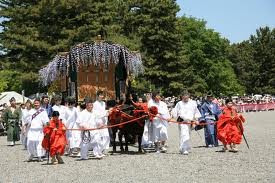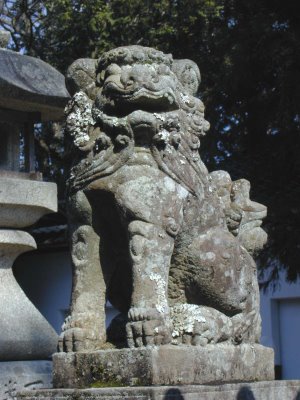[ . BACK to WORLDKIGO TOP . ]
:::::::::::::::::::::::::::::::::::::::::::::::::::::::::::::::::::::::::::::::::::::::::::::::::::
Kifune Shrine and its festivals
***** Location: Kyoto, Japan
***** Season: Various, see below
***** Category: Observance
*****************************
Explanation
Kifune matsuri 貴船祭 (きふねまつり) Kifune festival
... Kifune shinji 貴船神事(きふねしんじ)Kifune Shinto ritual
gokoosai 御更祭(ごこうさい)"changing the robes of the deity"
itadori matsuri 虎杖祭(いたどりまつり "knotweed festival"
kigo for mid-summer
Kifune, sometimes read Kibune (きぶね).
June 1
The most important yearly festival at
Kifune Shrine 貴船神社 in the
Kurama mountain region.
Its official name is
gokoosai 御更祭.
It used to be held twice a year, on the first day of the fourth and eleventh lunar month.
Kibune shrine belongs to the Kamo Shrines of Kyoto (sessha 摂社).
In the forests around the shrine there grow a lot of
itadori, Japanese knotweed.
People pick this plant and compare its length.
 . WKD : itadori いたどり Japanese knotweed
. WKD : itadori いたどり Japanese knotweed
Polygonum cuspidatum, looks like a kind of rhubarb.
quote
Kibune matsuri
Formerly this festival was held on the first day of the fourth and eleventh months at Kibune Jinja in Sakyō Ward, Kyōto City, Kyōto Prefecture.
Prior to the Meiji Period, when this shrine had an auxiliary shrine relationship to Kamowakeikazuchi Jinja (also known as Kamikamo Jinja, Upper Kamo Shrine), the festival was observed on a grand scale. In the past, on the day before the festival there used to be a kitchen knife ceremony, and
shinsen (sacred offerings) were placed in a chest (karabitsu).
Then, together with birds (kakedori), people presented these to the kami on the day of the ceremony.
After the ritual offering (hōbei) of nusa (sacred paper strips/streamers) and the intoning of norito (prayers) by the shinshoku (priests) they visited the branch and hilltop shrines and performed hōbei, then returned wearing flowers taken from the mountain peak in their hair.
At the midpoint in route between the Kibune and Upper Kamo Shrines a designated person chanted a secret song to which the other priests responded in a repetitive manner. Formerly, during the fourth month festival worshippers used to collect the Japanese knotweed that grew profusely on the mountain near the shrine in a competition for size and amount, thus leading to the popular name
itadori matsuri ("Knotweed Festival"). Vestiges of this ancient festival remain in the annual shin'yo (portable shrine) processional held on June 1, and in the festivals for the changing of the kami's robes (gokōisai) held on April 1 and November 1.
source : Mogi Sakae, Kokugakuin Uni
:::::::::::::::::::::::::::::::::::::::::::::::::::::::::::::::::::::::::::::::::::::::::::::::::::
 Kibune Shrine (貴船神社, Kibune Jinja),
Kibune Shrine (貴船神社, Kibune Jinja),
also known as Kifune Jinja, is a Shinto shrine located at Sakyō-ku in Kyoto, Japan.
It was founded more than 1600 years ago.
Legend tells us that
the goddess Tamayori-hime appeared on a yellow boat in Osaka Bay and said, "Build a sanctuary at the place where this boat stops and deify the spirit of the locality, and the country will prosper." The boat floated up the rivers of Yodogawa to the river Kamogawa, stopping at the beginning of the stream.
The deities enshrined here are
Takaokami-no-Kami and
Kuraokami-no-Kami. They are the gods of water, and people pray to them for rain during times of drought, and to stop the rain during floods.
One emperor offered a black horse in a drought, and a white horse during a prolonged spell of rain. This is why people now offer up votive plates with the image of a horse.
The shrine became the object of Imperial patronage during the early Heian period.In 965, Emperor Murakami ordered that Imperial messengers were sent to report important events to the guardian kami of Japan. These heihaku were initially presented to 16 shrines including the Kibune Shrine.
From 1871 through 1946, the Kibune Shrine was officially designated one of the
Kanpei-chūsha (官幣中社), meaning that it stood in the second rank of government supported shrines.
© More in the WIKIPEDIA !
京都市左京区鞍馬貴船町180
. Kuraokami, Takaokami 高おかみ神 , Kuramitsuha .
Deity of Rain
Amulets from Kibune Jinja

chinowa omamori ちのわ守り for summer purification


龍神札
Dragon God amulet
. The Dragon Art Gallery - 2012 .
御神水せっけん soap from sacred water
清砂 purifying sand
kajitori 梶取守

何事もうまくいく絵馬 -
may everything go well - amulet
all kinds of ema votive tablets and more
source : www.kibune.or.jp/jinja/omamori
tsuri yuki anzen 釣行安全 safety when fishing
ruaa mamori ルアー守 luer amulet
. Amulet for fishing from Kibune Shrine .
. Summer Purification (nagoshi, harae) .

むすび守袋型 Musubi bag form
むすび守文型 Musubi letter form
. Enmusubi 縁結び to find a good partner .
 貴船神社船土鈴
貴船神社船土鈴
clay bell of the yellow boat of Tamayori-Hime
A play of words with the name of the shrine, 黄船 "
yellow boat".
. Kyoto no dorei 京都の土鈴 clay bells from Kyoto .
.................................................................................
Suzuka Valley and Waterfall,
鈴鹿谷
The Main Shrine,
貴船神社本宮
The Rock Garden,
石庭
Page with many thumbnails of the places within the precincts.
http://www.kibune.or.jp/meisho/
. . .
Kibune Jinja / Kifune Homepage
http://www.kibune.or.jp/jinja/
Festivals
http://www.kibune.or.jp/jinja/event/
http://www.kibune.or.jp/jinja/kibune/saijiki.html
. . . . . every month:
tsukinamisai 月次祭 monthly festival
hatsu tatsusai 初辰祭 festival on the first day of the dragon
masshasai 末社祭 festival of the subordinate shrine
. . . . . Saijiki Events:
hatsu tatsu taisai 初辰大祭
. Grand Festival on the first day of the dragon in January
tondo とんど Tondo fire, January 15
amagoi matsuri 雨乞祭 Rain Ritual, March 9
Kifune matsuri 貴船祭 Grand Festival, June 1
Minazuki no oharae 水無月大祓
. Great Purification ritual in June, June 30
Kifune no mizu matsuri 貴船の水まつり
. Water Festival, July 7
Kikka shinji 菊花神事
. Chrysanthemum ritual, Spetember 9
Meiji sai 明治祭 Meiji festival, November 3
Kifune momiji matsuri 貴船もみじ祭
. celebrating red leaves, November 7
. . . . .
quote
In Kyoto, Kibune Shrine deifies Takaokami-no-kami, who is worshiped as a rain god. It is described in the Shoku-nihongi, the Nihon-koki, the Shoku-nihon-koki , the Montoku-tenno Jitsuroku, and the Sandai Jitsuroku that from 765, the seventh year of Tempyohoji, people prayed almost every year to Niu-Kawakami and Kibune for rain. They are said to have offered a black horse when they wanted the rains to start and a white horse when they wanted the rains to end because it was believed that the spirit of the gods descend to earth on a horse. Black is the color for casting a rain spell as it symbolizes dark clouds bringing rain. In contrast, white is the symbol of the bright sun.
These prayers were held as national events.
Sacred Water in Japan
Iwai Hiromi
 The Sacred Water 御神水 goshinsui
The Sacred Water 御神水 goshinsui
Even Murasaki Shikibu was aware of the powers of the water at Kibune Shrine. She came here to pray for the love of her husband, and her prayer was granted. Now the shrine is also worshipped by lovers, praying to the "god of good marriage". Workers also pray for a good relationship with their employers.
Even special soap is sold at the shrine.
:::::::::::::::::::::::::::::::::::::::::::::::::::::::::::::::::::::::::::::::::::::::::::::::::::

Oku no Miya 奥の宮
In the compounds, at the back of Kibune shrine, there is one of the three sacred
ryuuketsu 龍穴 dragon holes
This dragon hole inhabited by a white dragon, who brings prosperity to those who worship him.
It is a great "power spot" of Japan.
Once a carpenter lost his chisle, as it fell into the hole.
But to his surprize, a strong wind blew out of the whole and his chisle fell back on the ground in front of his feet.
Shrine Muro Ryuketsu Jinja 室生竜穴神社
Nara
. The Dragon Art Gallery – 2012 .
:::::::::::::::::::::::::::::::::::::::::::::::::::::::::::::::::::::::::::::::::::::::::::::::::::
Water festivel in Kifune
(貴船の水まつり) Kifune no mizu matsuri
at Kifune Shrine, July 7
 quote
quote
The origin of this festival is rain-making rituals.
Now is more like for showing our gratitude to water.
The festival consists of offering tea ceremony, dancing and cooking ceremony in front of the Gods. Tea cremony, of course, cannot be done without water, so it's the symbolic ceremony of this festival. And the cooking ceremony is offered by the special cooking school called
Ikuma school.
Ancestors of the Ikuma school used to be cookers for the Imperial family. It is said that the current master is 29th-generation of the family.
At the ceremony, he cooks a fish in front of the god without touching it by his hands at all. (The fish is altarage for Gods, so it shouldn't be touched by men.)
source : see-u-in-kyoto.blogspot.com
:::::::::::::::::::::::::::::::::::::::::::::::::::::::::::::::::::::::::::::::::::::::::::::::::::
. Amagoi Matsuri 雨乞祭 Rain Ritual
March 9
Horses offered to the gods in rain rituals.
水の祀
*****************************
Worldwide use
*****************************
Things found on the way
 quote
Kifune Festival held in Manazuru-cho,
quote
Kifune Festival held in Manazuru-cho,
真鶴 貴船まつり
Ashigara-shimo-gun, Kanagawa pref. is counted as one of Japan’s three largest marine festivals and a designated National Significant Intangible Folk Cultural Asset. The origin of the festival is dated back to the middle of the 17th century, when people began to put Mikoshi (portable shrine) on a ship to pray for purification of fishing boats and stone carrying boats in the harbor and then carried it around the village.
This old, traditional and pious festival is held on
July 27th to 28th, filling the whole town of Manazuru with air of excitement. As the festival is composed of a lot of exciting spectacles such as the colorfully carved Kobaya-bune boat, Manazuru-bayashi (traditional band playing music) lively cheering up the town, reverent Kashima-odori dance, and flower floats and Kaidenma (the towing boat) for which masculine strength is fully expressed, a lot of tourists from all over the country visit the town of Manazuru.
On these two days, the citizens of Manazuru all pull together to make this festival a great success.
source : nippon-kichi.jp
*****************************
HAIKU
 新緑や人の少なき貴船村
新緑や人の少なき貴船村
shinryoku ya hito no sukunaki Kifune mura
fresh green -
there are few people
in Kifune village
Hatano Soha (Sooha) 波多野爽波 (1923-1991)
source : weekly-haiku.blogspot.com
*****************************
Related words
*****
. 貴船神社 Kibune Shrine, Buzen Kagura
Iwado Kagura of Buzen, 岩戸神楽 in Kyushu
Autumn, O-Bon
*****
. Kibunegiku 貴船菊 (きぶねぎく) wild aster from Kibune
shuumeigiku 秋明菊(しゅうめいぎく) "bright autumn chrysanthemum"
Anemone japonica
kigo for mid-autumn
*****
. kawadoko ryoori 川床料理
food served on a riverbed veranda
In Kyoto, near shrine Kibune Jinja 貴船神社 served in the forest restaurants along the clean river.
kawayuka 川床(かわゆか)riverbed veranda
BACK : Top of this Saijiki
:::::::::::::::::::::::::::::::::::::::::::::::::::::::::::::::::::::::::::::::::::::::::::::::::::::::::::::::::::::::::::
[ . BACK to DARUMA MUSEUM TOP . ]
[ . BACK to WORLDKIGO . TOP . ]
:::::::::::::::::::::::::::::::::::::::::::::::::::::::::::::::::::::::::::::::::::::::::::::::::::::::::::::::::::::::::::


























































